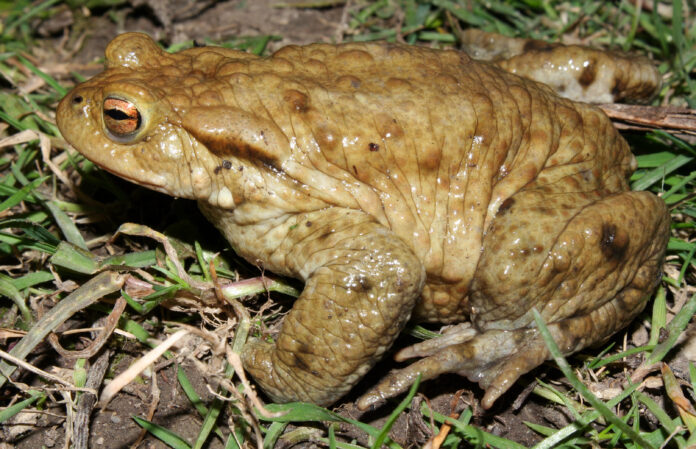ADVISORY WARNING: In recent years, growing demand for bufo in the psychedelic community has placed an enormous strain on the Bufo alvarius toad (aka Sonoran Desert Toad, Colorado River Toad) (Carpenter, 2020). The species is currently threatened and conservation efforts are underway to have the species formally classified as endangered. The toads are routinely captured and harassed as part of the process of gathering their venom. Techniques for gathering venom are often extremely unethical and inhumane, involving cruelty and injury to the toads. For these reasons, PEx strongly advises against the use of bufo. As alternatives, synthetic 5-MEO-DMT or natural 5-MEO-DMT in plant form (e.g. yopo snuff) offer an extremely similar experience without the negative aspects of animal abuse and the ongoing issues surrounding conservation and sustainability.
Furthermore, there have been numerous recent reports of abuse and unethical behavior involving prominent bufo administrators and self-titled shamans. These reports are wide-ranging and involve multiple individuals. The severity includes rape, sexual harassment, violence, and death. The two specific facilitators named in these allegations are Dr. Octavio Rettig and Dr. Gerry Sandoval. You can read an open letter from the entheogenic community here. For more information on the allegations, go here.
What is bufo?
Bufo is the common name given to the venom of the Bufo alvarius toad, also known as the Colorado River Toad, Sonoran Desert Toad, and El Sapo/Sapito. Bufo alvarius is native to Northwest Mexico and some Southwestern areas of the United States.
Bufo contains naturally-occurring 5-MeO-DMT, which is a powerful psychedelic compound. 5-MEO-DMT is closely related to DMT (N, N-dimethyltryptamine) and produces similarly intense effects. In addition, unlike pure synthetic 5-MeO-DMT, bufo also contains bufotenin (5-HO-DMT).
What is the bufo experience like?
Typically, bufo is vaporized. The experience is intense but relatively short, peaking around 1-15 minutes after ingestion and lasting around 30 minutes in total. Participants report out-of-body experiences, “white outs,” and strong open-eye visuals.
Brief history of bufo
While many in the psychedelic community claim to use bufo for shamanic or neo-shamanic practices, there is no evidence of indigenous or traditional use of bufo. Some images of toads have been located in Mesoamerican temple frescos, but the ingestion of the toad venom for medicinal or shamanic purposes is unsubstantiated and purely speculative. The first known incidence of smoking bufo occurred in the 1980s. However, the consumption of 5-MeO-DMT in plant form, as in yopo snuff, has been used in traditional shamanic rituals.
Bufo Safety
In terms of general safety, there are several physical and psychological risks attached to 5-MeO-DMT. 5-MeO-DMT should never be combined with MAOIs (including ayahuasca), or with beta-carbolines, as there are multiple cases where death occurred when combining bufo or other sources of 5-MeO-DMT with these other substances (Sklerov, Levine, Moore et al., 2005;). 5-MeO-DMT should not be combined with prescription medication, over-the-counter medication, or some herbal supplements, such as St. John’s Wort. Some studies indicate the possibility for hyperthermia when ingesting 5-MeO-DMT (Jiang, Shen & Yu, 2015).
There are also psychological risks involved with 5-MeO-DMT, including bufo. Many participants report the experience to be extremely intense and potentially overwhelming, with frequent “white outs” and episodes of memory loss that make it potentially difficult to integrate the experience. There are anecdotal reports of persistent anxiety, paranoia, and sleep disorders after a single dose. It is important to pay attention to dosage, set, setting, and sitter. Check out the PEx general guide to psychedelic safety for more recommendations and tips.
Bufo Science
The primary active psychedelic component in bufo is 5-MEO-DMT, although bufo venom also contains bufotenin, another psychoactive molecule.
Structurally, 5-MEO-DMT is similar to DMT (N, N-dimethyltryptamine), and it functions through the serotonergic system. The molecule has a strong binding affinity with the 5-HT1A serotonin receptor subtype (Shen, Jiang, Winter & Yu, 2010). Unlike DMT, however, 5-MEO-DMT has a methoxy group in the R5 position. It is thought that 5-MEO-DMT may also interact with noradrenaline and dopamine uptake inhibition, in addition to serotonin.


